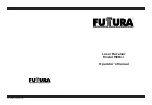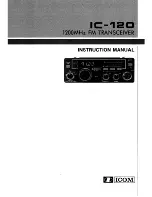
5
12
Installation
Position the blade or bucket to the desired elevation (benchmark).
If using on and excavator or backhoe, the dipperstick should be vertical
and the bucket “curled” or extended to a position that can be easily
duplicated each time a reading is taken. To check that the plane of
laser light is intersecting the pipe where the receiver will be mounted,
move the receiver up and down along the length of the mounting pipe.
Ideally you should be able to move the receiver far enough in either
direction to utilize the entire reception range - receiving all the grade
displays and the lost beam indicators. If the full reception range is
not being used, raise or lower the rotating laser until the full reception
range is utilized.
Turn both the top and bottom knobs counterclockwise until the mounting
clamps in back open enough to fit around the mounting pipe and place the
receiver on the pipe. Move the receiver up or down until the “On-Grade”
symbol is displayed by the LED’s. Tighten both clamps firmly by hand.
NOTE: Do not mount on painted poles if possible. Paint may accumulate
on the clamps and deteriorate the clamps gripping capacity.
When mounted to a bulldozer, motorgrader, scraper or other grading
machine, the operator can keep the blade at the proper elevation by
manually controlling the blade so that the receiver stays within the “on-
grade” zone. The LED display indicates in which direction the blade
needs to be moved to return to “on-grade”.
When mounted to an excavator or backhoe, the receiver is a grade
checker and allows the depth of cut to be monitored from the cab of
the machine by the operator. This is done by putting the dipper stick in
the vertical position and the bucket in the setup position and touching
the bottom of the ditch.
To remove the receiver from the machine, loosen the two clamps. Store
and transport the receiver in its carrying case.
Battery Installation / Charging
Built-in overcharging protection prevents damage if the unit is left on charge
after being fully charged. There is also protection to prevent charging alkaline
batteries.
CAUTION:
Do not attempt to charge alkaline or other
disposable batteries.
NOTE:
Do not charge Ni-MH batteries when ambient temperature
exceeds 113° F (45° C) or is less than 32° F (0° C).
The rechargeable battery electronics include a charge status and charge error
indicator located on the back of the housing.
Charge Status Indicator:
The LED will remain solid when the unit is charging.
The LED will blink when fully charged. When charged, unplug the charger from
the outlet and remove the cannon adapter from the accessory connector.
Charge Error Indicator:
If the batteries seem to be in a totally drained state
initially, the charge circuit will try to gradually charge the batteries. If charging
is unsuccessful after approximately 20 minutes, the LED will turn on solid
indicating an error with the internal battery connection, improper battery
insertion, the wrong type of battery, or a dead battery cell.
A blinking charge error LED indicates the unit is too hot or too cold to charge.
Charging will automatically start when the temperature is within the above
noted ranges.
Battery Replacement
- Remove dust cap, loosen thumbscrews, and remove
battery access cover. Remove old batteries. Install new batteries as described
on previous page.
Refer to your local requirements for the proper disposal of batteries.
(Located on lower rear of polycarbonate housing)
Charge Status Indicator
Solid - Charging
Blinking - Charging Complete
Charge Error Indicator
Solid - Battery Problems
Blinking - Temperature
out of limits






































